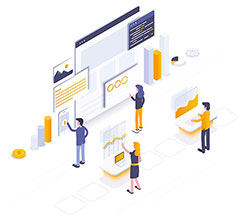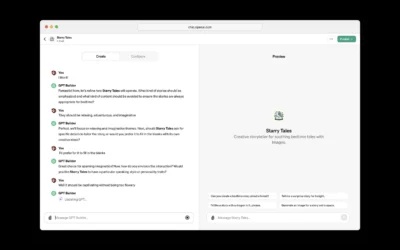How to Automate Workflow Without Writing Any Code
7 Steps to No Code Workflow Automation
In this project guide we’ll help you think through the most expensive steps in this process. Once you get to Step 7 you should be armed with enough information to make serious decisions about your project. We have a lot of business process experts who can assist in greater detail. Our goal here is to help you save time and money in getting started – along with setting reasonable expectations for the project.

Step 1: What is the desired business outcome?
Step 2: Create a list of business processes that impact the desired outcome.
Step 3: Define and map your business processes.
Step 4: Establish a wide budget range and a ROI threshold.
Step 5: Find an expert in your industry.
Step 6: Create a short list of potential no code workflow platforms.
Step 7: Engage in a proof of concept project.
Step 1: What is the desired business outcome?
In our experience observing many millions of dollars invested in no code workflow technology we’ve seen two different types of projects.
Type 1 – “One Hit Wonders”
Type 2 – “Culture Shifting Career Makers”
One Hit Wonders are projects that typically started somewhere outside of the no code development frame of mind. A team needed to build XYZ and they are looking at all of the software development options on the table. The internal software engineering team is too busy. The quote from that agency was too high. That off the shelf tool was close, but we’d still need a lot of customization. Ooh – what is this workflow / business process management / rapid application development / platform thing?
Teams and projects that match the One Hit Wonder pattern typically value the finish line more than the future. This may not be a fault. If the business logic, workflow, or user interface of the business application won’t need to change in the next 12-24 months, then the ability for the business to change stuff without code doesn’t matter as much. Throughout the project they’ll probably discover a few cool ways to take advantage of that idea even though it wasn’t a priority. That might spark a fire for future projects, but for this One Hit Wonder we just need to build XYZ on budget so users can do ABC. Chances are it will be successful – we see very high success rates across all of the software vendors we’ve interviewed and had experience with compared to custom software development.
Culture Shifting Career Makers on the other hand are strategic projects that will change how a company manages its workflow and adapts to the changing world around it. The internal software development cycle for the majority of projects will change. Leaders of these projects understand the value of having the business update business logic, workflow, and user interfaces as the demands of the business change. It’s not just about this budgeted project at hand for this group. They also want to set up a pattern of solution development for future projects. They want to test launch new products, each with unique workflows every week. They want to apply the insights gathered from all of their business intelligence software quickly with changes to how a workflow behaves. They want year end reviews to be based on workflow that can be measured in real time.
No matter the approach, it’s important to begin with the desired business outcome in mind. What business problem needs to be solved? Is software the best way to solve that problem? If so, what features and functions does that software solution need to support? How do each of those features and function tie to a measurable impact on the business outcome?
Step 2: Create a list of business processes that impact the desired outcome.
This step is all about evaluating where you are and thinking ahead to what the rest of the project is going to require. The goal here is to stay high level and gather feedback. You and your team have identified a problem. Now, what are all of the business processes or workflows that touch that problem?
For example, you might have identified a problem at the end of each sales quarter where you are losing deals because your organization isn’t collaborating on deal terms fast enough to get a final signature from the customer. The list of workflows could include your deal terms review process, your legal review process, your customer on-boarding process, and many others.
In some cases you might need to break down what has traditionally been one big business process into several smaller pieces that clearly outline the role and responsibility of each participant. If you find yourself stuck here it might be a good opportunity to engage one of our business analysis experts who are proficient in process mapping. These are some of our favorite people, and you’ll need them for step 3 too. They could save you a ton of time.
Step 3: Define and map your business processes.
Now that you have a list of all of your business processes, it’s time to get down to the details. What are the steps involved for each participant? What decision points dictate how they proceed from step to step? What data is needed along the way for each person to do their job?
Having all of this definition is going to accelerate any software development project. The cool part about a no code software project is the mapping of this stuff is exactly what you’ll be doing to build the software application! The only problem is, you haven’t purchased that tool yet. So, you can settle for a plain old diagram builder. There are a ton out there, but our favorite is LucidChart. (Yes, that is an affiliate link so we can get paid if you do end up with one of their paid plans. Don’t worry, they have a great free plan that should get you through this project.)
Don’t have time for this? Remember that expert we suggested in Step 2? Well, this won’t be the last time we remind you about them.
Step 4: Establish a wide budget range and a ROI threshold.
Wide? Threshold? Why not just pick a number? Yeah, we get it. This is a hard question that depends on a lot of variables so we had to think of a way to answer the question without getting in trouble. If this isn’t your first rodeo, then you get it.
The big idea here goes back to the common types of workflow automation projects we’ve observed through multiple vendors and many millions of dollars worth of spend. If you are looking for a One Hit Wonder project and you are a small businesses with a small number of workflow, then you are looking at anywhere from less than one hundred dollars per month to a few thousand dollars to get the job done. If you are a large enterprise and you want to go for the Culture Shifting Career Maker, then be prepared to spend six to seven-figures (we’ve even seen eight and nine figure projects) on the company wide solution. Companies in the $5M to $80M/year revenue range can do an awful lot of good for two to eight thousand dollars per month (the cost of a part time or full time employee can free up the equivalent of multiple FTE’s).
The range is large for a lot of reasons, but we want you to be prepared for spend here that can make a big difference. So in addition to setting a wide budget range – be open to ideas from experts and vendors that might be a little more expensive, but can make you a lot more money in the long run.
If you need some private feedback on your budget here, feel free to drop us a line.
Step 5: Find an expert in your industry.
We told you we’d bring up the expert one more time. Don’t worry, its for a good reason. And yes, it is optional.
At this point you should have mapped out business processes and money set aside to get the project done. If you are going to get this done, then you really have two choices. You can a) start building your list of potential no code software platforms or b) find an expert who knows your space and already has a great list of platforms that have done the job before.
See? We told you it was for a good reason. Did we mention we have a great list of no code experts standing by ready to help?
Step 6: Create a short list of potential no code workflow platforms.
This is probably going to be a “best googler competition” among your team. Don’t worry, a lot of people do it that way. In fact, we learned that term from a friend shooting for a Culture Shifting Career Maker project at the largest global security and aerospace company in the world. Lucky for you, we have a cheat sheet of the best low and no code workflow platforms.
Getting a little more serious here – the objective here is to match the complexity of your workflow, capability of your team, and changes you expect in the business to the right technology at the right price.
Not sure where to look? We’ve helped thousands of other businesses. We can help you to.
Step 7: Engage in a proof of concept project.
Now that you have a list of potential platforms that you think can support your workflow project, its time to de-risk the purchase. Every vendor will offer a public webinar or private demonstration of their project, but that isn’t going to tell you what its like to live with the thing after the purchase. You could opt for a free trial, and most vendors will oblige. However, in our opinion, a free trial is one of the worst ways to evaluate a workflow platform.
No free trial?! Yes. No free trial… yet. The most important outcome of a free trial is how capable your team, or a new hire, is of maintaining and changing the workflow. The problem? Free trials are either a blank canvas, or an unrelated application that might not be worth your time.
What is a proof of concept?
A proof of concept is a mini-project that you work on with the vendors on your shortlist to prove the idea of living with their product after your purchase. It is not a complete build out. Instead, you will work with the vendor and/or your expert to determine the most critical samples of the project that will give you a reasonable idea of what the final solution will be like.
Not every vendor is open to this idea. Many are. Some even offer a free phase or two of a proof of concept.
If you are working with a vendor who isn’t open to a proof of concept, then we’d recommend finding an expert who can run an independent proof of concept for you. Sign up for a free trial, or negotiate a paid trial with the vendor and explain to them that you have an expert who is going to build out a pilot and if that goes well then you are going to pay for the full plan.
Is a proof of concept the only way to make a good decision? No! Remember, the goal is to see what life will be like after the purchase. If your team is confident in their ability to pick up the tool and run with it, then by all means, make the purchase and get started.
Related Blog Articles
OpenAI Launches No Code App Store for Agent Building
OpenAI plans to release no code tools so that anybody can build what they call GPT's for their upcoming GPT store. Similar to how the App Store adds value to Apple products, OpenAI's GPT Store will be a way for developers to submit GPTs (think "apps") that enrich the...
Client On-Boarding Space Heats Up with No-Code
HelloFlow is a no-code client onboarding platform Fintech, providing a solution so you can build a sleek customer experience. All while using the latest digital identity verification services to ensure regulatory compliance. While many other newcomers to the space...
Custom IT Asset Management without Code
IT Asset Management can make a big part of the IT organizations life easy - or very, very painful. Issuing laptops, or managing a BYOD policy should be simple, but even simple things change. The cost of change is one of the biggest barriers to happy IT teams. As the...
Need help getting started?
We created these guides from our own experience and are standing by to help you.



